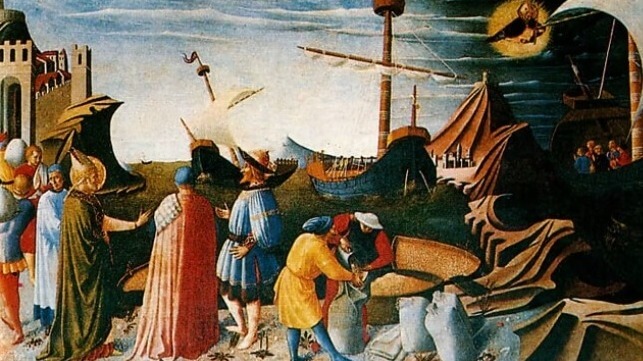The Original Shipping Miracle: St. Nicholas and the Grain

Every year, the shipping industry helps Santa Claus to bring Christmas cheer to households across the West. This modern tradition can trace its roots back to a much earlier supply chain miracle-worker: The original Santa Claus, St. Nicholas of Myra (~270-343 AD), who saved a port city in present-day Turkey by procuring a cargo of grain. There are several versions of this legend, and the St. Nicholas Center has given TME permission to share these early shipping stories with readers in the maritime industry.
Famine Relief, or The Miracle of the Grain
Version I [1]
When crops failed, famine descended throughout Lycia. The people of Myra were hungry. Bishop Nicholas was very concerned about the people's welfare.
In far off Italy, a merchant loaded his ship with grain to sell in Egypt. That night Bishop Nicholas appeared to the merchant in a dream. He pledged payment of three gold coins, and commanded the merchant to come to Myra and sell the grain. The merchant was amazed and frightened when he awoke to find three gold coins miraculously in his hand.
Since the merchant was afraid to ignore such a command, he sailed to Myra and sold all his grain. The people had food and would be able to survive the famine. Still amazed, the merchant told everyone about his dream and the gold. The citizens listened to his story and were amazed. They thanked God for their good fortune and for their extraordinary bishop, Nicholas.
Version II [2]
During a famine in Myra, Bishop Nicholas worked desperately hard to find grain to feed the people. He learned ships bound for Alexandria with cargoes of wheat had anchored in Andriaki, the harbor for Myra. The good bishop asked the captain to sell some of the grain from each ship to relieve the people's suffering. The captain said he could not because the cargo was "meted and measured." He must deliver every bit and would have to answer for any shortage. Nicholas assured the captain there would be no problems when the grain was delivered. Finally, reluctantly, the captain agreed to take one hundred bushels of grain from each ship. The grain was unloaded and the ships continued on their way.
When they arrived and the grain was unloaded, it weighed exactly the same as when it was put on board. As the story was told, all the emperor's ministers worshiped and praised God with thanksgiving for God's faithful servant Nicholas.
Back in Myra, Saint Nicholas distributed grain to everyone in Lycia and no one was hungry. The grain lasted for two years, until the famine ended. There was even enough grain to provide seed for a good harvest.
Version III
There is another early Byzantine variant to this story, which is one of the oldest legends about Saint Nicholas. It takes place after the saint's death, and is illustrated in a painting (shown at top) by Fra Angelico which is in the Pinacoteca of the Vatican. It tells the story in three scenes.
The first shows a port with one ship at anchor and another just coming in, before a background of a walled town with a fortress. In the foreground St. Nicholas is asking the ship's captain for grain. The center of the painting shows longshoremen shoveling grain into sacks, while others carry bags of grain into the town. The last section shows the ship moving away with Nicholas shown above in a circle of light, guiding and protecting the ship.
The grain stories show an effective and resourceful Nicholas helping his people in times of need—in ways both normal and miraculous—during his life, and even after his death.
Sources
[1] The Russian version is told in Service, Akathist, Life and Miracles of Saint Nicholas the Wonderworker, Holy Trinity Monastery, Jordanville, New York. A complete translation of the Life and the Miracles of St. Nicholas as it appears in The Lives of the Saints in the Russian Language as set forth according to the guidance of the Menologiion of St. Dimitry of Rostov, Moscow, Synodal Press, 1903.
[2] "The Life of St. Nicholas the Bishop" from The Golden Legend by Jacobus de Voragine (1275)
This article appears courtesy of The St. Nicholas Center and may be found in its original form here.
The opinions expressed herein are the author's and not necessarily those of The Maritime Executive.
